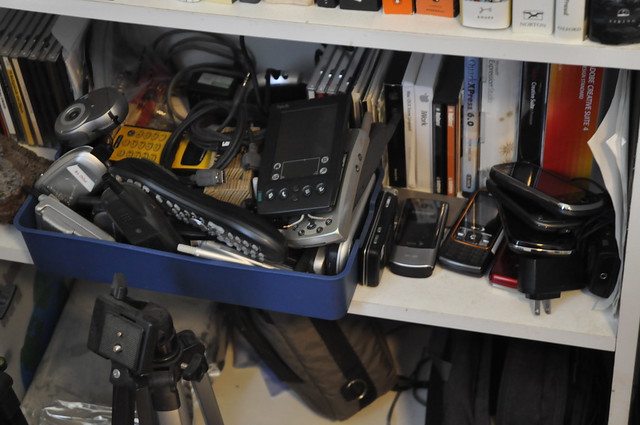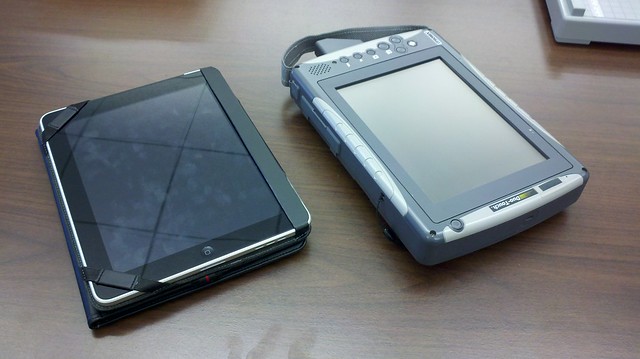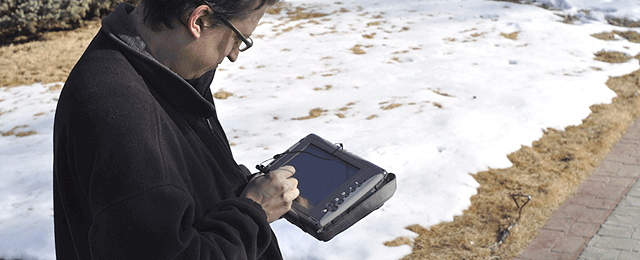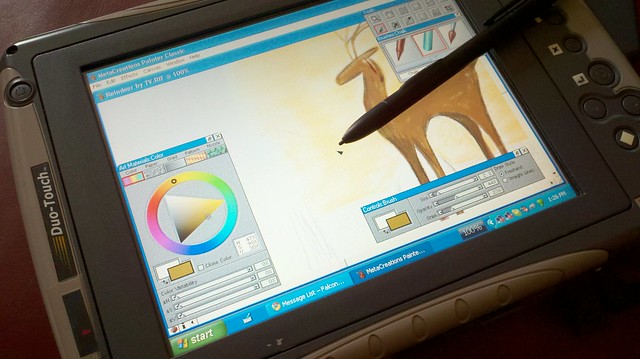 I have, for almost ten years now, been collecting everything I can in the mobile and small screen device arena. Sadly, I missed some good ones before I started formally collecting. And there are a lot of good ideas, or pure versions of design concepts that have become muddled over time. This also helps
I have, for almost ten years now, been collecting everything I can in the mobile and small screen device arena. Sadly, I missed some good ones before I started formally collecting. And there are a lot of good ideas, or pure versions of design concepts that have become muddled over time. This also helps
But today, I want to talk about tablets. There are at least three things that can mean. I don't mean digitizer tablets (a la Wacom) though I use the hell out of those, and regularly have to demo and suggest them. But I do want to blur the lines between the other two, the PC Tablet and the Media Tablet. The Media Tablet is an iPad. And all things like it. I have some issues with the definition and don't think much of them owning the space when "like an iPad" is the defining characteristic. I'd rather see something more broken down by user needs, or as a device that solves those problems regardless of label, and open it up a bit. To me, this would conflate:
- eReaders
- Media Tablets
- PC Tablets
So, let's take my solution to this. It's not just a Tablet PC, but a quite thick and heavy one, an Itronix DuoTouch IX325. Oh, and I should stop and mention that though I do not own an iPad, Kindle, Nook, Galaxy Tab or anything else in this range, I have used a lot of them. eReaders especially, I have borrowed from the office for a weekend. I've played with pre-production hardware for some items. Yes, I've worked on some products involving these, and have done a bit of legitimate research. I really feel I have enough experience short of spending two years and $5000 toting them around to tell what I like and don't like.
 I went with the PC tablet mostly because I do not want to consume on a digital device nearly as much as I create or otherwise interact. And I certainly don't want to create with whatever nerdy little program, or crippled version of something I am eventually graced with. I like the ability to use the same old software, in much the same old way.
Sure, it has other good features for my lifestyle, like that it's waterproof and relatively indestructible. And has a high quality GPS built in. I do things on the side like make maps, and that's useful. But carrying it around and using it as a sort of laptop/eReader/iPad replacement has led me to find some things that it does which I find to be really, really good.
I went with the PC tablet mostly because I do not want to consume on a digital device nearly as much as I create or otherwise interact. And I certainly don't want to create with whatever nerdy little program, or crippled version of something I am eventually graced with. I like the ability to use the same old software, in much the same old way.
Sure, it has other good features for my lifestyle, like that it's waterproof and relatively indestructible. And has a high quality GPS built in. I do things on the side like make maps, and that's useful. But carrying it around and using it as a sort of laptop/eReader/iPad replacement has led me to find some things that it does which I find to be really, really good.
 First, it's not perfect by a damned sight. The bad:
First, it's not perfect by a damned sight. The bad:
- It's thick. Yes, like five times thicker than an iPad. Or is it? It doesn't need a case. Really, I carry it around loose, so even with the feet and hand strap it's only about twice as thick as an iPad it the case. And /everyone/carries their iPad in a case.
- It's heavy. Again, about twice as heavy.
- It should be expensive. I got mine off eBay and finagled to get it to work. But retail is around $4000. Sure, it's rugged, but that matters. Not sure what price point you could reach for a rugged device, but it has to be cheaper than this.
- Battery is so so. They didn't go as far as they could with this. It's just a laptop really, so some mobile-phone designer input would have helped with power management. I can squeeze a bit over 4 hours out if I carefully turn down backlight all the time, but it's just at 2 hours without any care. This is not quite enough to be convenient.
- Windows is not a mobile OS. Even with the precision of the pen, sometimes it's a bit hard to hit a tiny, desktop-like target. This is a constant reminder of how mobile is not just "cellphone" and how you need to change interfaces for mobile users.
- It's still not a mobile OS. The input panel, and a few other bits and pieces are nice. But it has no quick and easy notification system. The lock screen is in no way an idle screen, so I can't tell battery or time, much less see anything else. It's everything that's bad about the non-contextuality of desktop computers.
 But I am still carrying it around, happily, so why?
But I am still carrying it around, happily, so why?
- It has buttons. Kind of a lot of them. Modifiers cuts them down, so there's no dedicated volume or brightness, though I can get to them without a software panel. But what do I use most? Enter, then the scroll keys. I find myself using them very much like I do a desktop, which isn't bad. Type, select, etc. then whack the enter key to commit. No need for a simple, often-used control to require fussy precision to hit.
- Retro-reflective. The screen works in sunlight. Not with brightness, but with a reflective backplane. The two input screens obscure it some, but pick up a very old phone and check it out. They could work in full sun with NO backlight. We need to get back to that, in all devices.
- Touch AND pen. This one has a button combination to switch, but I like the digitizers that are clever enough to turn on touch when the pen is not present. Anyway, gives a great flexibility. Just poke with your finger for lots of typical uses, get the pen out for precision. And the pen is a pressure pen. Much better for handwriting, and it works with graphics programs.

- Handwriting wins. The input panel is damned neat. Manual switch from writing, to letter entry, to a virtual keyboard. I use, about 99% of the time, the straight up handwriting recognition. In slow, clunky windows, this is so good I cannot believe it. I have written a fair bit of the book on it. It's fast, it can be done standing and walking, and it's not much more error prone than typing. I did some un-scientific studies, and really it's about as bad as when I just type. The difference is just in how easy it is to correct errors. A bit clunkier on the tablet, but that's a pure interaction design solution; I can think of a few ways to improve it with very little technical effort.
- Its walkable. In several ways. It would be better if it was lighter, but the overall layout, the bezel shape, and this neat handle/strap thing on the back mean you can carry it with one hand and write with the other. And I mean, reliably, with no worry about dropping it. I went for a 2 mile run with it once, just holding by this handle. Sure, anyone could make an add-on strap like this. They should.
- Rugged. Most of all, I cannot tell you how freeing this is, compared to the relative fragility of most of our electronics. My tablet has a handle, and nothing else. I just pick it up and carry it around. If it bumps into something, so what? I have been walking through the airport with my luggage, and one finger on the handle for the tablet while the device dangles away. Not everything needs to have a hard drive heater, or meet a milspec for water proofness, but /some/ ruggedness would be very nice for these devices we carry around all the time.
1 comment:
Well! I think I don't really want everyone to start carrying around Windows Tablet PCs. It's got a downside for sure. But there's a lot more to the world than beating the top-dog in what is perceived to be the market space. Thanks for sharing such a nice article.
Large Tablets
Post a Comment